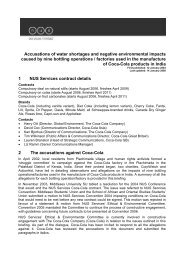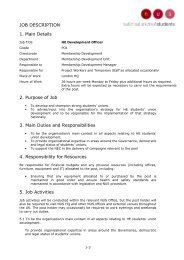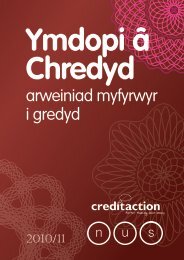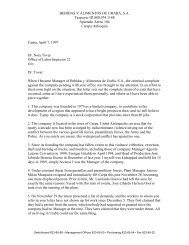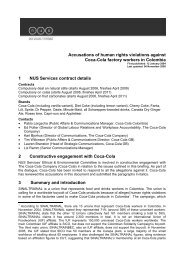Carbon Ambassadors Energy Audit Checklist
Carbon Ambassadors Energy Audit Checklist
Carbon Ambassadors Energy Audit Checklist
You also want an ePaper? Increase the reach of your titles
YUMPU automatically turns print PDFs into web optimized ePapers that Google loves.
<strong>Carbon</strong> <strong>Ambassadors</strong><br />
<strong>Energy</strong> <strong>Audit</strong> <strong>Checklist</strong><br />
Key energy saving opportunities<br />
1<br />
2<br />
3<br />
4<br />
5<br />
6<br />
7<br />
8<br />
9<br />
General Questions to ask<br />
What are the organisations<br />
opening hours? What are the<br />
periods of most energy use, for<br />
example when the building has the<br />
most number of staff in it?<br />
What is the organisations main<br />
business?<br />
Are there any bits of equipment<br />
that tend to use a lot of energy<br />
connected with their main<br />
business?<br />
How many employees does the<br />
organisation have?<br />
How many users of the building<br />
are there in a typical week?<br />
Does the organisation have a<br />
shut-down procedure for<br />
evenings and weekends?<br />
Does the organisation have a shutdown<br />
procedure for extended<br />
periods of the building being<br />
completely shut?<br />
What is the electricity tariff that<br />
the organisation is on? This can<br />
be checked by looking at their bill<br />
or contacting their electricity<br />
supplier.<br />
Is the organisation on a ‘green’<br />
tariff or receive renewable<br />
electricity at all? Their tariff will be<br />
higher in this case but their carbon<br />
footprint will be lower (or nonexistent<br />
if they have 100%<br />
renewable electricity).<br />
What is the organisations main<br />
focus in completing the audit? To<br />
save money or reduce carbon<br />
emissions?<br />
Has the organisation had an<br />
energy survey or audit before?<br />
Are there any major<br />
refurbishments or upgrades<br />
planned?<br />
10 What is the annual electricity bill<br />
for the organisation approximately?<br />
Comments<br />
No of bulbs/electrical<br />
item & wattages<br />
1
1<br />
2<br />
3<br />
4<br />
5<br />
6<br />
7<br />
8<br />
9<br />
Equipment<br />
Is equipment that is not required<br />
overnight switched off? Games<br />
machines; photo machines;<br />
vending machines; laser printers,<br />
water coolers; tea urns and any<br />
other equipment.<br />
Is all equipment switched off at<br />
the wall at the end of the<br />
day/when not needed and not left<br />
on standby? Check water coolers,<br />
TVs, vending machines, printers<br />
etc.<br />
Are the computer monitors the<br />
old style CRT monitors rather than<br />
modern efficient LCD monitors?<br />
Is there more than one laser<br />
printer per five members of staff<br />
(approx)?<br />
Do any staff have kettles and<br />
fridges in their offices for their<br />
own use? Communal facilities<br />
should be used at all times.<br />
Is the voltage over 244 Volts in<br />
any part of the building? (If you<br />
have an energy tracker you can<br />
use this to check but don’t worry<br />
about this if you don’t have one).<br />
What are the energy ratings of<br />
various pieces of equipment in the<br />
business? (If you can see them on<br />
the <strong>Energy</strong> Display Certificates<br />
stuck to the item).<br />
Do staff only fill kettles with<br />
enough water for their cup of tea<br />
as opposed to the whole kettle<br />
being filled for one cup?<br />
Can any equipment be switched off<br />
using timers? This reduces<br />
dependence on human behaviour<br />
to switch off.<br />
Comments<br />
No of bulbs/electrical<br />
item & wattages<br />
Fridges<br />
Are ice machines located near to<br />
glass washers/cooking equipment<br />
10<br />
which creates heat? Are they in<br />
well-ventilated areas?<br />
Are any bars regularly not used for<br />
48h or more? If so, are the bottle<br />
11<br />
fridges switched off during these<br />
periods of non-use? If not why not?<br />
Is the fridge set to temperature<br />
12 setting 2-3 as opposed to the<br />
highest setting?<br />
Are the blinds on the dairy deck<br />
13<br />
fridges closed overnight?<br />
Does the freezer have more than<br />
14 2cm of ice build up? Check the<br />
freezer box of fridges too.<br />
2
15<br />
16<br />
Do any of the fridges have dirty or<br />
dusty radiators? These should<br />
be cleaned often to heighten<br />
efficiency. Are there any cracks in<br />
the door seals?<br />
Are fridges/freezers actually used?<br />
If not they can be unplugged, and<br />
possibly disposed of.<br />
17<br />
18<br />
19<br />
20<br />
21<br />
22<br />
23<br />
24<br />
25<br />
26<br />
Heating, cooling and<br />
ventilation<br />
Are the users of individual rooms<br />
happy with the temperature of their<br />
rooms? If not controls and timers<br />
need to be checked and adjusted.<br />
If the main ventilation equipment is<br />
being switched off by timers, when<br />
was it last checked to make sure it<br />
is working and at the appropriate<br />
timings?<br />
Is it set to 'timed' on the control<br />
panel, or has it been set to 'manual<br />
override'?<br />
Is ventilation/air conditioning<br />
switched off as soon as possible<br />
after areas close?<br />
Are bar areas still using<br />
equipment designed to divide<br />
smoking and non smoking areas?<br />
These should now be switched off<br />
given the smoking ban. Fan<br />
speeds on ventilation systems<br />
should also be reduced to reflect<br />
the reduction in pollution in the air.<br />
For any areas with air conditioning,<br />
what are the set point<br />
temperatures on the control<br />
panels? Ideally they will set to<br />
24˚C. They should not be less than<br />
20˚C.<br />
If air conditioning is being used,<br />
are all windows and doors closed<br />
and radiators turned off?<br />
If any portable electric heaters<br />
are being used, has the<br />
organisation eradicated any<br />
draughts / installed insulation over<br />
false ceilings?<br />
Are current central heating<br />
radiators on appropriate<br />
temperature settings and<br />
unobstructed by boxes, tables<br />
etc?<br />
Is the central heating thermostat<br />
set at around 18˚C? It might need<br />
to be a little higher depending on<br />
users of the building?<br />
Are any extraction fan grills grimy<br />
or dusty? If yes they will be<br />
working inefficiently.<br />
Comments<br />
No of bulbs/electrical<br />
item & wattages<br />
3
27<br />
28<br />
29<br />
If there is a swimming pool, is it<br />
covered every night?<br />
Are there any draughty areas in<br />
the building? If so there are many<br />
types of cheap draught-excluding<br />
methods that can be used to<br />
combat this.<br />
Is the venue using as much<br />
natural lighting and ventilation<br />
as possible?<br />
30<br />
31<br />
32<br />
33<br />
34<br />
35<br />
36<br />
37<br />
38<br />
39<br />
Lighting<br />
Are there any old standard<br />
tungsten filament bulbs (typically<br />
60W or 100W) in use? Especially<br />
look over pool tables / in uplighters<br />
/ in desk lamps. Please<br />
count them.<br />
Are there any Halogen spotlights<br />
(these will be 25W or 50W) in use<br />
in kitchens or bathrooms (these<br />
bulbs will have the pronged<br />
endings)? Please count them.<br />
Are there any Halogen spotlights<br />
(these will be 25W or 50W) in use<br />
in mains voltage areas such as<br />
corridors and main rooms (these<br />
bulbs will have the circular<br />
endings)? Please count them.<br />
Are there any old fluorescent T12<br />
tubes in use? These need to be<br />
changed to the newer, more<br />
efficient T8 tubes. Please count<br />
them.<br />
Does the building have any<br />
energy-efficient fluorescent T8s,<br />
T5s or compact fluorescent<br />
bulbs? Please count them.<br />
Does the building have any<br />
energy-efficient LED lighting at all?<br />
What time do the cleaners clean<br />
each area? Does the organisation<br />
leave lights on for the cleaners?<br />
Do the cleaners leave the lights on<br />
after they have finished?<br />
If this is the case it is useful for you<br />
to count up all the lightbulbs and<br />
wattages in the building so we can<br />
calculate the savings possible.<br />
Are there any motion or light<br />
sensors in the building?<br />
Are there any lights on where there<br />
is adequate natural lighting?<br />
Check atriums and foyers, any<br />
corridors with lots of windows and<br />
outside lighting.<br />
Are any areas over-lit? Look at<br />
corridors and meeting rooms.<br />
Could every other bulb be<br />
removed?<br />
Comments<br />
No of bulbs/electrical<br />
item & wattages<br />
4
40<br />
41<br />
42<br />
43<br />
44<br />
45<br />
Are there any areas with lights on<br />
and no-one in the room?<br />
In areas with large banks of light<br />
switches are there labels to direct<br />
users to the right switches?<br />
Are there any light bulbs that are<br />
flickering or blown but are still in<br />
the socket? These need to be<br />
removed even if there is no<br />
replacement bulb available<br />
immediately.<br />
Are there any outside lights in<br />
use? Are these turned off when<br />
not needed or on a sensor?<br />
Can desks/furniture be moved<br />
around in line with light switches<br />
and organisation?<br />
Is it more efficient to use desk<br />
lamps rather than central lighting?<br />
Water<br />
Do the toilets have any watersaving<br />
devices installed? Such<br />
46<br />
as Hippos?<br />
Are all urinals regulated by either<br />
47 a motion sensor or a flow restrictor<br />
pressure valve?<br />
Is the tap water too hot? Look for<br />
‘warning/caution’ signs that have<br />
48 been placed above taps. The<br />
cylinder thermostat should be set<br />
to 60˚C/140˚F.<br />
49 Are there any dripping taps?<br />
Awareness<br />
Do staff turn lights off when they<br />
50<br />
go to lunch / meetings?<br />
Do staff turn their computers off<br />
51 if they are away from their desks<br />
for more than an hour?<br />
Are there awareness stickers by<br />
the light switches? These are<br />
52<br />
available free from the <strong>Carbon</strong><br />
Trust.<br />
Do staff receive training or<br />
53 guidance on how to reduce energy<br />
consumption?<br />
Comments<br />
No of bulbs/electrical<br />
item & wattages<br />
5




